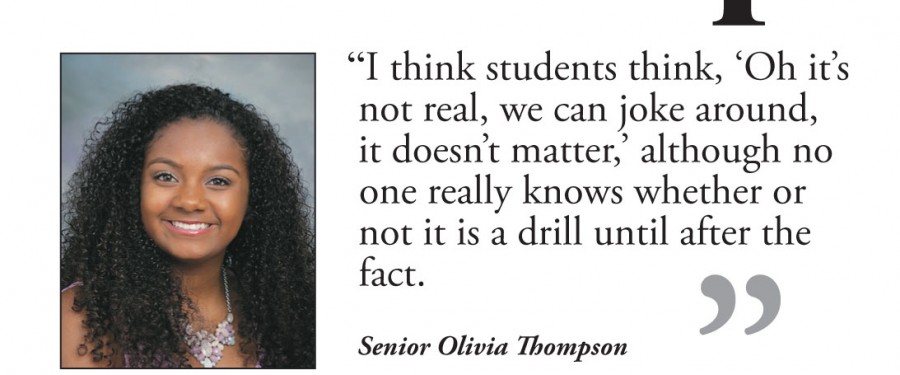Routineness of safety drills in school causes complacency
The intercom turns on, signaling that the school is going into lockdown. Students begin evacuating their seats to go sit along the wall out of view from the door – out of sight of a potential school shooter – but after the teacher locks the door and shuts the blinds, they stop the class.
It’s just a drill, stay in your seats and keep working, the teacher says.
The problem is, it isn’t always a drill – if students and staff are not prepared for a real event, it could spell disaster for more people than a teacher trying to squeeze in a lesson.
Violence on school campuses has become a reality in the 21st century. Just last month there was a shooting at a West Valley high school – last year there was one at an East Valley school. This only enhances the importance that PHS is prepared for such an event; the school prepares through lockdown drills.
The procedure for a lockdown has become routine: turn off the lights, cover the windows, sit out of view from the windows and stay quiet until the lockdown is over. Teachers do not know when a lockdown is coming or if it is a drill, unless they have a student with a medical condition that requires them to be notified, one teacher states.
“I think it’s always taken really seriously after an incident,” math teacher Jennifer Dominguez says. “Sometimes we look at it as a drill and no big deal when it probably should be taken seriously every time.”
Yet, in a recent survey, students claimed that several teachers were continuing to teach throughout lockdowns, which could put student’s safety at risk.
“[Lockdowns] are important because it is easy to go through motions when nothing’s happening, and you want it to be that common thread where everyone knows what to do in case something actually happens,” one of these teachers says.
According to the student survey, there are teachers who continue their lessons during lockdowns. One teacher’s reasoning is that the drills could last from two minutes to 10-minutes, and “the students that are in the middle of that lockdown should not lose valuable instruction time,” the teacher said.
“I don’t just teach, I talk to them about why we have [lockdown drills],” the teacher said. This educator discusses past shootings that have occurred in schools across the country.
“I think [lockdown drills] are important,” the teacher said, “though I think they happen a little bit too often. We have rules and regulations set by the state and city, so I understand that.”
One of the teacher’s concerns is that students do not take them seriously, and simply use the time to use their cell phones and mess around with their classmates.
A second teacher agrees with the first: from the free time that lockdowns enable, to the frustrations over lost instructional time, this teacher also says they have continued teaching during lockdowns.
“During a lockdown, I’ve continued to push [students] away from the door and talk to them if I knew that it was a drill,” this teacher explains.
They also express, “I think they’re really important, if they’re taken seriously. I think that for student safety that we do need to take them seriously.”
This teacher explains their reasoning for not following certain parts of lockdown protocol as more of a classroom management issue than anything else. The teacher claimed that students would be on their cell phones, talk and damage books and papers while sitting in the corner of the room.
These teachers are not the only ones that have disregarded areas of the protocol. Principal Dan Serrano stated that after a drill, a list is compiled by the Gilbert Police Department of teachers that did not follow certain parts of the protocol.
After this happens Serrano says, “we [administration] talk to those teachers about that.”
The level of seriousness that these drills are regarded with can be seen in the behavior of students as well, as the first teacher says, “students will only take those things as serious as the teacher does.”
Most students do not expect these drills to ever become a reality. So many spend the lockdown on their phones, playing rock, paper, scissors, or whispering to the person next to them. The consequences of these actions could be severe in the event of a real lockdown, which most do not think about.
Senior Olivia Thompson agrees saying, “I think students think, ‘Oh it’s not real, we can joke around, it doesn’t matter,’ although no one really knows whether or not it is a drill until after the fact.”
Yet, even recently it has proven that dangerous incidents can happen in Arizona. With a gun threat at Hamilton, a shooting at Independence and a bomb threat at Willis Jr. High, it shows the importance of preparing for a real lockdown.
“If everyone were to practice lockdowns in a more serious matter, everyone including both students and staff would be more equipped to handle the situation in a safe and precautious matter,” Thompson says
The attitude towards lockdowns seems to be leading students and staff alike to be desensitized of the seriousness of these situations. As Serrano says, “whether it is practice or not, you have to follow protocol.”
